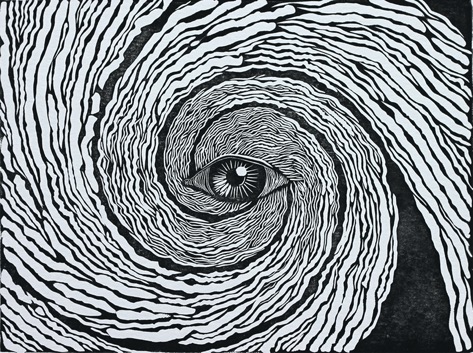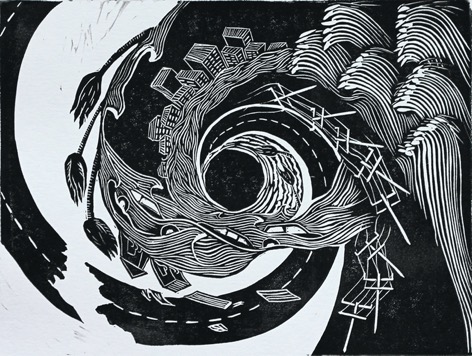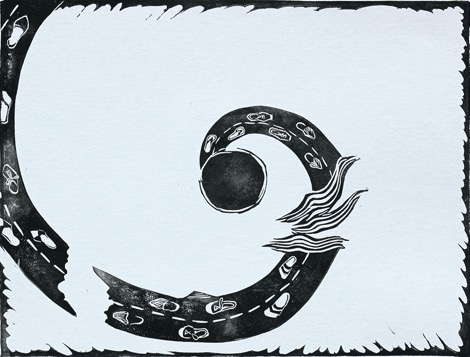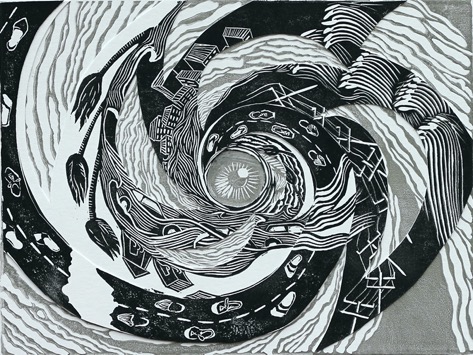En el Ojo del Huracán // In the Eye of the Storm:
Conceptualizing Climate Justice
Read Artist Statement – Final Capstone Report – Artist Presentation – Purchase Prints : Proceeds to El Puente’s Latino Climate Action Network
This foundational print of the series depicts a hurricane swirling counterclockwise in the Northern Hemisphere like the storms that reach Puerto Rico. The eye of a hurricane is a moment of pause, windless and calm, when we can see the storm around us more clearly. Our human eyes, our lived experiences, can tell us: which systems of governance make that wind around us even more damaging? Which systems support us when the wind blows and after it is gone?
Following the swirl of the storm, this print brings the human impacts to the forefront. A storm surge threatens buildings, flood waters wash away cars and infrastructure, wind bends trees and destroys power lines, and homes are blown away. Here we are placed within the storm itself, as it happens in a discrete moment in time.
Time is continuous in this panel, depicting the ongoing impacts of losing a loved one or a sense of community. Floodwaters may subside, but grief lingers. The voidness of the print evokes emptiness felt with such deep loss and the deafening silence after the storm. The shoes are a symbol of the 4645 lives lost in María, echoing the memorial in Puerto Rico where thousands of shoes were laid out in tribute to those individuals and in resistance to the government’s grossly low death estimates.[1] These shoes follow the road out of the storm, to calmer places.
[1] Florido, A. (2018, June 1). An Impromptu Memorial To Demand That Puerto Rico’s Hurricane Dead Be Counted. National Public Radio. https://www.npr.org/2018/06/01/616216225/an-impromptu-memorial-to-demand-puerto-ricos-hurricane-dead-be-counted
Incorporating all elements of the previous prints, this composite image overlaps the storm itself (Figure 1), the infrastructure impacts (Figure 2), and the community impacts (Figure 3). The human eye is central, reflecting our lived experiences of storms and denoting a shift from natural hazard to natural disaster with the addition of the human elements. Visually, this print is deliberately cluttered to express a sense of chaos and confusion experienced in a hurricane. Each layer plays with time: impacts continue to be felt throughout time in the constant foreground, while the storm itself fades into memory like the translucent ink dulls into the background.
Artist Statement
92 years ago, my grandma was tossed out of a second-story window to escape San Felipe, the worst recorded hurricane to hit Puerto Rico until María hit decades later. Communities were torn apart as the only two documented Category 5 hurricanes ripped across the Island, one almost a century ago and the other 3 years ago.[1] My family, like countless others, lost everything in that 1928 storm and emigrated to the mainland. These pieces are in remembrance of those lived experiences.
As climate change worsens, storms like these will likely become more common and more severe in the region.[2] We are the eye of the storm, our human experiences translating each hurricane from hazard to disaster. Often the loss is not just of property and land, but of life. Mirroring a local memorial of María, sets of shoes follow the road to calmer places in recognition of the 4,645 lives lost. [3] Because these experiences are complex and entangled, each piece is overlaid on top of the other to build one final print that reflects this chaos and urgency.
These images can be interpreted literally, as a hurricane and its numerous impacts, or they can be more symbolic: watching ourselves twist in a storm system of inequities that caused Puerto Rico to be without power for 328 days after María,[4] with impacts still being felt years later, largely due to a lack of US governmental support.[5] As the eye of the storm, we witness all.
[1] Fritz, A. (2017, September 19). Puerto Rico has a long history with tropical storms. None of them were like Hurricane Maria. The Washington Post. https://www.washingtonpost.com/news/capital-weather-gang/wp/2017/09/19/puerto-rico-has-a-long-history-with-tropical-storms-none-of-them-were-like-hurricane-maria/
[2] Reidmiller, D.R., C.W. Avery. (2018). Impacts, Risks, and Adaptation in the United States: Fourth National Climate Assessment, Volume II: Chapter 20. U.S. Global Change Research Program. doi: 10.7930/NCA4.2018. https://nca2018.globalchange.gov/chapter/20/
[3] Florido, A. (2018, June 1). An Impromptu Memorial To Demand That Puerto Rico’s Hurricane Dead Be Counted. National Public Radio. https://www.npr.org/2018/06/01/616216225/an-impromptu-memorial-to-demand-puerto-ricos-hurricane-dead-be-counted
[4] Fernández Campbell, A. (2018, August 15). It took 11 months to restore power to Puerto Rico after Hurricane Maria. A similar crisis could happen again. Vox. https://www.vox.com/identities/2018/8/15/17692414/puerto-rico-power-electricity-restored-hurricane-maria
[5] Clement, S., Zezima, K., & Guskin, E. (2018, September 12). Puerto Rico After Maria: Residents see a failure at all levels of government. The Washington Post. https://www.washingtonpost.com/news/national/wp/2018/09/12/feature/residents-see-a-failure-at-all-levels-of-government/
Purchase Prints: Proceeds to El Puente’s Latino Climate Action Network
These handmade prints are being sold with 100% of profits going to a climate justice organization in Puerto Rico, El Puente. More about the organization can be found on their website, here.
Costs: As all funds go to meaningful climate justice work, please pay whatever you’re able: sliding scale donations begin at $65 each for Pieces 1, 2, and 3, and $120 each for Piece 4. This includes the costs of shipping, paper, and ink, with the remainder going to El Puente. Receipts will be documented for transparency.
Each linocut is 9×12 inches, printed with borders making the full piece 12×16 inches total.
To receive a piece, please email sclausni@ucsd.edu with the following: which piece(s) you’d like, the $ amount of your associated sliding-scale donation, and your shipping address (or local pickup in the San Diego area).




